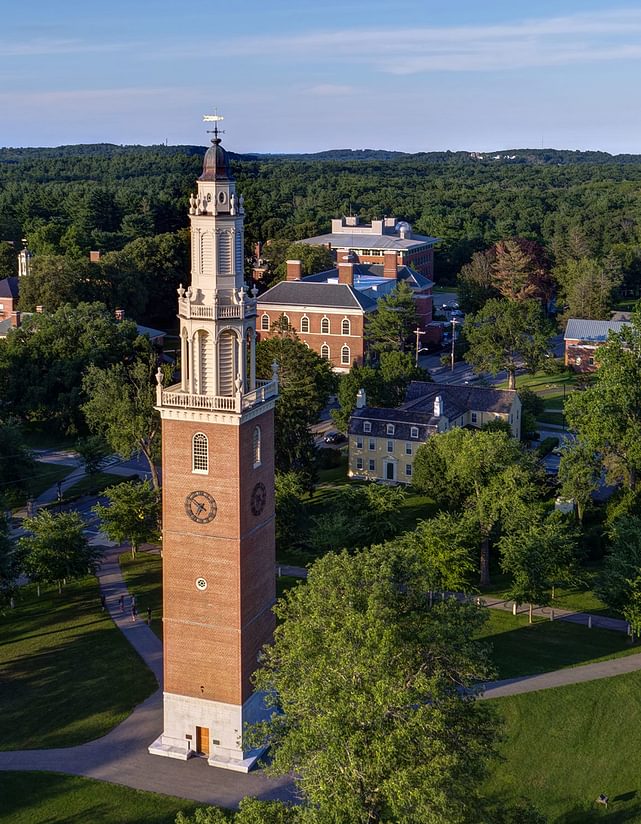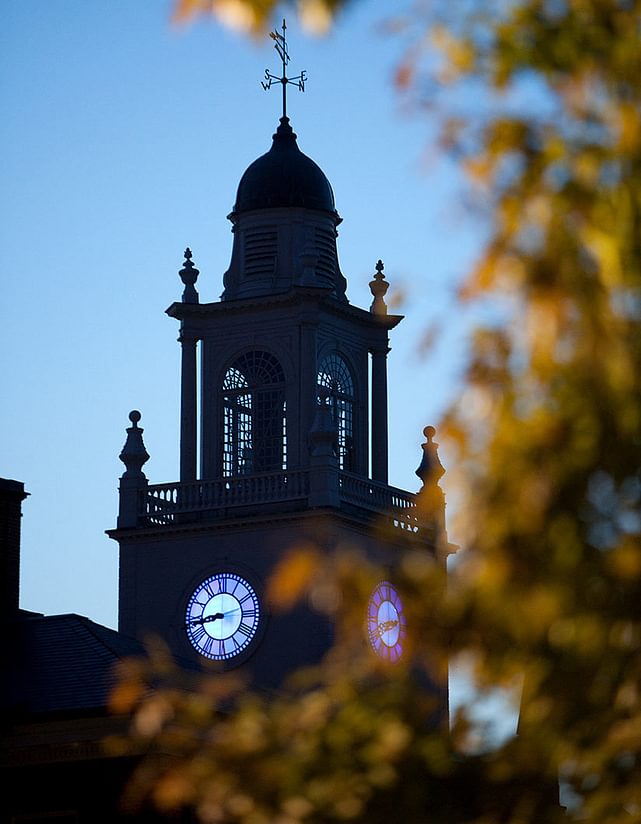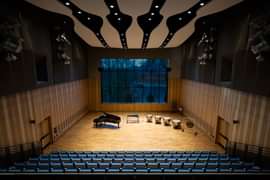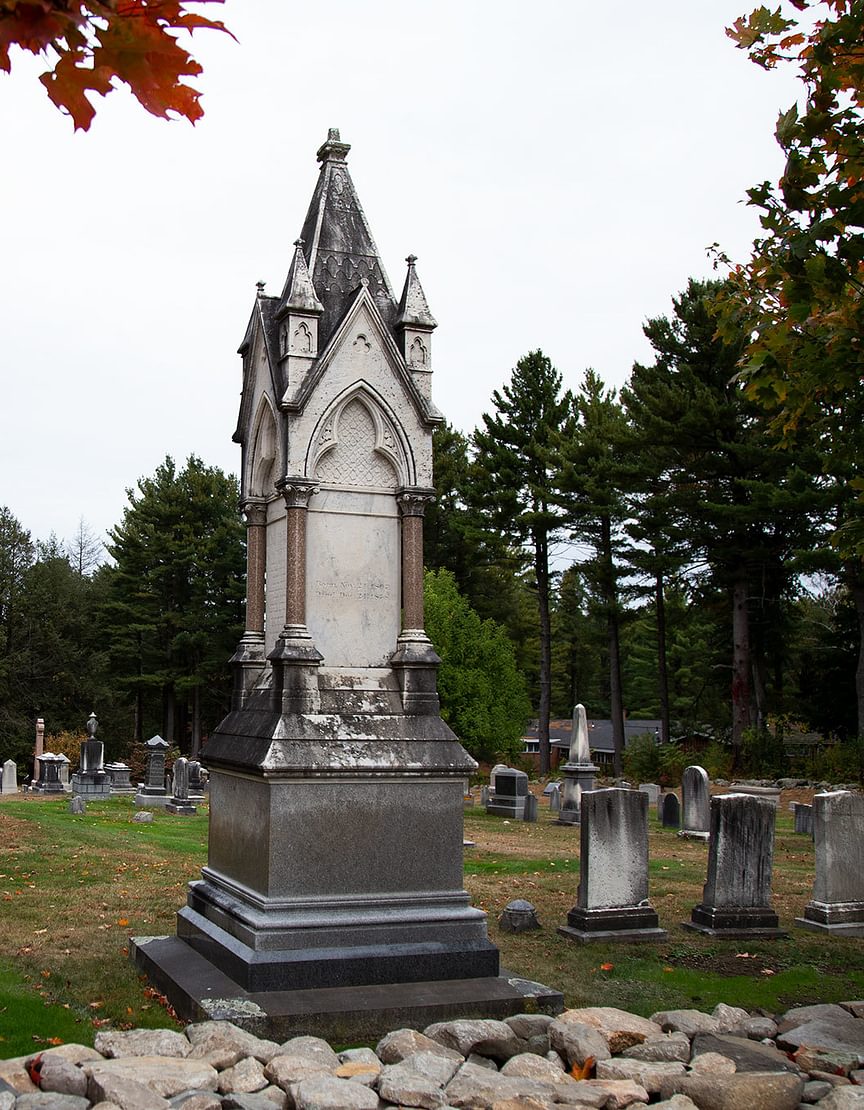
October 28, 2019
Horror stories
Andover courses get dark and scary just in time for Halloweenby Neil Evans
Something wicked has crept into Andover classrooms this fall, possessing faculty to teach the dark side of literature and history. Through supernatural connections or pure coincidence, several course offerings this term examine ghosts, hauntings, death, horror, and unsettling iconography. Read on, if you dare. 👻
Gothic Literature: Living in The Tomb
Paul Tortorella ’80
This course traces trends in Gothic forms, from their origins in the damp and dark castles of Europe to the aridity of the contemporary American landscape. Students identify gothic conventions and themes such as the haunted house, family dynamics, apparitions, entrapment, secrecy, and the sublime. They also will read novels, short stories, and poetry spanning roughly 200 years in order to explore questions about the supernatural, the psychology of horror and terror, the significance of fantasy and fear, the desire for moral closure, and the roles of gender, race, class, and sexuality.

How did you become interested in this topic?
I was 14 or 15 years old and I had a babysitting job for these people down the street. This was the early days of cable TV and after the kids had gone to bed I would watch HBO, which was forbidden fruit because it had R movies on. It was October, about 10:30 at night and I began watching The Omen. It freaked me out. The parents came home about midnight, paid me the 5 bucks and I walked outside. It's midnight, October, and I have to walk home now after watching some unbelievably frightening supernatural things happen to people. I start walking up the hill and all of a sudden it's getting windy, out of nowhere the trees are moving, trying to break loose from the ground and consume me. I look up, I look behind, and BAM! I started sprinting home like my life depended on it. I got to our front door, dove in the house and locked the door behind me. I lived. Watch The Omen. You will understand.
I guess I have been someone who always tried to face my fears. So I teach Gothic to beat the devil at his own game.
What are some of your favorite themes or motifs in this genre?
Ghosts. Haunted House. A ghost can be defined as something that is and isn't there. All reading is ghost reading. The Haunted House? That's you.
Scariest/darkest/creepiest/chilling story in your syllabus?
Bruce McCallister's story “The Girl Who Loved Animals.” He wrote it in the early eighties, and it takes place in a futuristic city where technology, tattoos, video games, and plastic surgery has gone way overboard. It's a story, among many things, about mothering and the lack of mothering. Now look at the title. A masterpiece.
I guess I have been someone who always tried to face my fears. So I teach Gothic to beat the devil at his own game.
”Blood Roots: Horror Literature and Its History
Dr. Sara Erdmann
Author Carmen Maria Machado writes that, “Horror is an intimate, eerie, terrifying thing, and when it’s done well it can unmake you.” From historical hauntings to modern-day slashers, horror literature as a genre has existed for centuries. Beginning with Walpole’s 1765 medieval terror The Castle of Otranto, we will study the field’s evolution from gothic horror to contemporary scary stories, exploring the distinctions between gothic, psychological, and supernatural horrors, among others. Machado goes on to say that horror “tells us a lot about who we are, what we are, and what we, individually and culturally, are afraid of,” a claim which will guide us as we dive into ghastly and macabre tales that captivate a culture and hold a mirror up to our truest selves.

How did you become interested in this topic?
I’ve been reading horror for a long time, and I tend to come back to stories that tread the line between hauntings and mental illness narratives. My favorite stories are the ones that function on two levels: as classic scary stories and also as a character losing touch with reality. I want to leave the story and decide for myself how much of the terror actually happened, and how much might come down to a character’s unreliability or even metaphor. Medical horror is another favorite: with how much we still don’t understand about disease and the human body, this area is ripe for exploration when it comes to instilling fear in a reader.
How have students responded to the course material?
This is the first time I’ve taught the course, so I’m still figuring out student responses to the material I’ve chosen. We just finished The Turn of the Screw, and we’re starting The Haunting of Hill House this week. In many ways, horror as a genre is rapidly expanding and being taken more seriously as its margins blur and varying authors and filmmakers try their hand at it. With constant media access, we can read about horrors happening all over the globe in real time, and horror literature has continued to change to reflect our lived experiences. In my mind, this makes now the perfect time to look back and explore the evolution of a field so long dismissed by the literary community.
Scariest/darkest/creepiest/chilling story in your syllabus?
I’d have to say the most unsettling story on my syllabus is The Haunting of Hill House. Something about that novel resonates with me, particularly Eleanor’s desperate desire to belong. But I’ve also made sure to include some short stories by Stephen King, Octavia Butler, and Carmen Maria Machado that could give Shirley Jackson a run for her money. I tried to touch on all kinds of horror (supernatural, spiritual, etc.) in hopes that my students will walk away with a real understanding of the genre’s breadth as well as its potential to teach us about humanity.
My favorite stories are the ones that function on two levels: as classic scary stories and also as a character losing touch with reality.
”Skulls, Angels, and Hour Glasses: Early New England Gravestone Iconography and Field Research
Dr. Donald Slater
This course investigates 17th-, 18th-, and early 19th-century gravestones in the towns of Andover and North Andover. Through readings, lecture, discussion, and most importantly, fieldwork in local colonial burial grounds, this course strives to answer several questions: How do gravestone styles change over time? How can these changes in style allow us to understand evolving religious thought in early Andover? Can we use this data to understand broader theoretical patterns of the change of material culture? What is the meaning of the graphic imagery and poetic epitaphs on colonial gravestones? What can we do to preserve these cultural resources for the future while making them more accessible to the public? Serving as the launch for a long-term project, this practicum course will lay the groundwork for photographic and three-dimensional documentation of stones, as well the development of a database of all artistic, poetic, and biographic information recorded on stones.
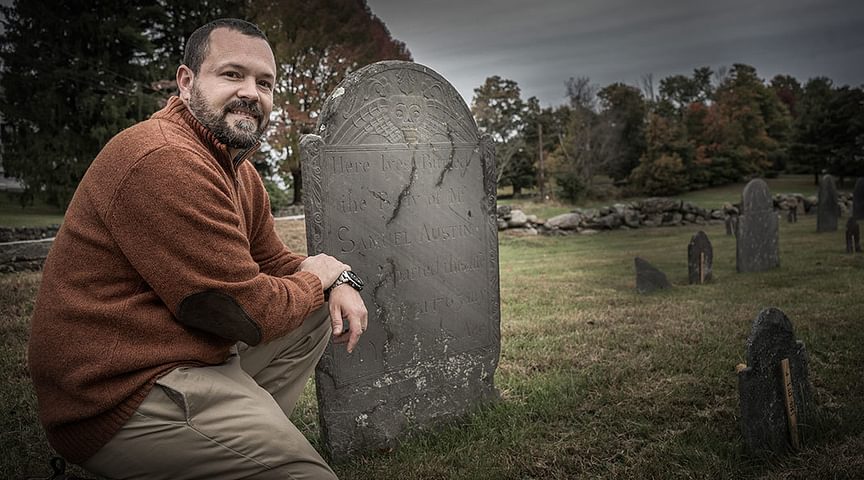
How did you become interested in this topic?
I started becoming interested in old New England burial grounds when I was in sixth grade. While all the cool kids were swimming, one day I decided to walk to the overgrown and forgotten burial ground that was along the side road into the club. I remember encountering all kinds of crooked, dilapidated, and ancient stones as I waded through a sea of chest high grass. I didn’t know anything about colonial burial grounds at the time, but the sense of adventure, discovery, and mysteries obscured by the ages captured my young imagination. Over the years, my passion for these often under-appreciated outdoor museums has grown and I am delighted to now teach an entire course on the subject.
What are some of your favorite themes or motifs in this genre?
Most of my archaeological pursuits across a number of different cultures have involved the intersection between materiality, iconography, and spiritual beliefs. Following this theme, I most enjoy studying the graphic elements that early New England peoples chose to include on their gravestones. Many of these early yards are full of stones festooned with winged skulls, hour glasses, and crossbones, accompanied by the Latin phrases memento mori (remember [your] death) and fugit hora (time is fleeting). Much of this seems connected to earlier European ideals concerning the ephemeral nature of life on earth and the need for humans to prepare and turn a watchful eye towards one’s fate after death.
Scariest/darkest/creepiest/chilling story in your syllabus?
Our studies have definitely led us into some macabre territory that has involved funerals, murder, witches, demons, and even the walking dead. Although not the creepiest story, perhaps once of more unusual real life tales concerns one of the methods that European and early New England peoples tried to ward off evil entities believed to invade homes: the use of witch bottles. Archaeological finds, backed up with period ethnographic accounts, document that these bottles were often buried beneath a home’s hearth. But it is the contents of the bottle that raises an eyebrow. The potion could including bent pins, hair, nail clippings, urine, and possibly even belly button lint! I suspect that such a concoction would keep more than just the witches away!
¡El Cuco! Ghosts, Spirits, and the Supernatural in Latin America
Jineyda Tapia
The course focuses on how Latin American writers in the 20th-century weave paranormal presences into their stories—a literary tool that has become reflective of trauma or historical strife. Selected works may include Jorge Luis Borges, Gabriel García Márquez, Isabel Allende, Ana Castillo, Andrea Saenz, and Junot Díaz.
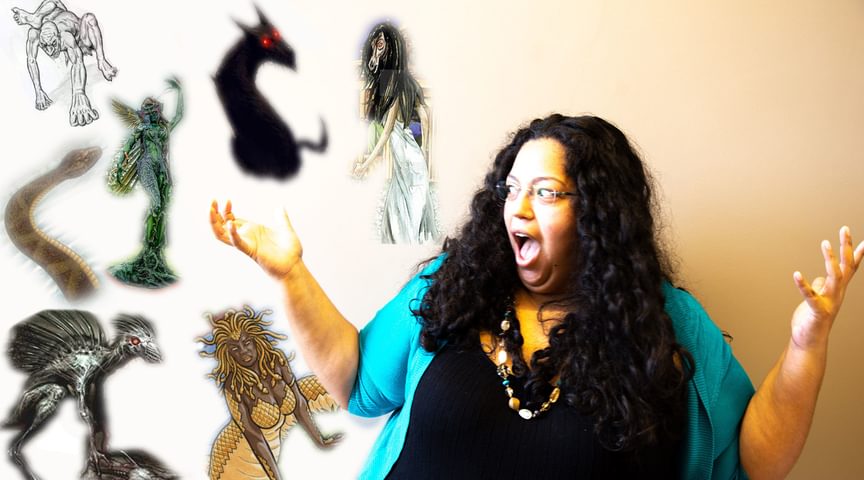
HOW DID YOU BECOME INTERESTED IN THIS TOPIC?
Throughout Latinx American cultures, the Cuco figure(s) originate from places of fear or protection. Interestingly, some Cucos were inverted as a way to empower people whose agency was stripped through social or physical violence and many others have been utilized by these cultures as a way to resist colonization. I see these Cucos as endearing since they are ways humans empower themselves past our fears, traumas, and social injustices.
Shout out to the seniors who’ve researched their Cuco. Many had to translate sources since the primary texts are in Spanish. I’m so proud of them.
